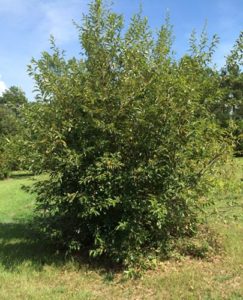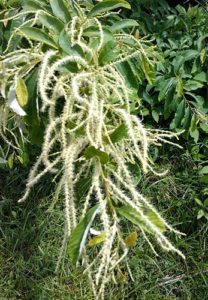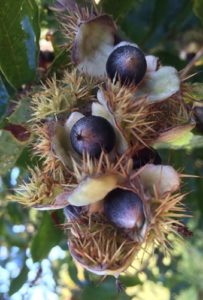By: Anthony Trimboli

When it comes to native nut producing trees and shrubs the oaks get most of the attention. The mostly gone but not forgotten American chestnut also gets a ton of press, even though there is no blight resistant variety available – yet.
While trees are excellent nut producers, they are not the best choices in all situations. Small yards and shrub/scrub management areas are perfect places to utilize native nut producing shrubs. One of the best, and sadly underutilized nut producing shrubs is the Allegheny chinquapin (Castanea pumila), also known as the dwarf chestnut.
Biology and Life History
Allegheny chinquapin is native from Texas and Oklahoma, across the southeastern states and north into the southern portions of New England. Dry, acidic to normal soils are preferred and moist to wet soils should be avoided when planting because root rot can be a problem. Allegheny chinquapin does well in full sun to partial shade.
Although it can be grown as a small tree that will reach 15-30 feet in height if trained to do so, it grows naturally as a smaller, usually 15 feet or shorter, multi-stemmed, thicket forming shrub. It is somewhat blight resistant and even if killed back to the root system it will resprout with no ill effects (as long as the roots are strong). Like its larger relative, the Allegheny chinquapin produces nut filled burs, but unlike the larger chestnut, the chinquapin only produces one nut per bur.

Pollinator and Wildlife Uses
Allegheny chinquapin nuts are small – about the diameter of a dime. They are eaten by a wide variety of wildlife including northern bobwhite, wild turkey, larger songbirds, deer, squirrels and other small mammals. It is also a host plant for several moth and butterfly species. The flowers are wind pollinated but the ample pollen is collected by native bees and honeybees.
Human Uses
The nuts of the Allegheny chinquapin are sweet and quite edible – many say better than chestnuts – but good luck beating the critters to them. The main reason they have not been produced as a commercial crop is due to the nuts being held tightly to the spiny bur. When chestnut burs break open, on the other hand, the nuts spill out which makes them easy to gather with mechanical harvesting equipment.
Incorporating Allegheny Chinquapin into Your Yard
The biggest obstacle to using this native dwarf chestnut in landscaping and wildlife plantings is the low commercial availability of planting stock. While some native plant nurseries do carry it, most do not. This is probably due to the tenderness of Allegheny chinquapin sprouts in their first fall.
Chinquapins sprout soon after falling from the burs, and some precocious nuts will sprout in the burs. These sprouts will grow to a few inches tall before going dormant for the winter. If the temperatures get too low the sprouts will freeze and die. This tenderness can make propagating them on a large scale tricky in some locations.

One tip for buying Allegheny chinquapin nursery stock is to get the largest size available. Three-gallon plants tend to have a high survival rate when planted out into the field. Smaller sizes can do well but will require more care and supervision to make sure they survive.
Weed management will greatly increase survival and be sure to take measures to keep deer off the young trees. Otherwise, the deer will browse the saplings and/or thrash the trees with their antlers! Wire cages can go a long way to getting chinquapins established.
Summary
If you have space for a large shrub and want to add nut to your wildlife plantings, I encourage you to investigate Allegheny chinquapin. It is a great option that provides not only nut, but pollen for native pollinators. It is a great way to get all the positive attributes of the mighty American chestnut in a pint-sized package.

Backyard Ecology: Exploring Nature in Your Backyard
Nature isn’t just “out there.” It’s all around us, including right outside our doors. Hi, my name is Shannon Trimboli, and I am the host of Backyard Ecology. I live in southcentral Kentucky and am a wildlife biologist, educator, author, beekeeper, and owner of a nursery specializing in plants for pollinators and wildlife conservation. I invite you to join me as we ignite our curiosity and natural wonder, explore our yards and communities, and improve our local pollinator and wildlife habitat. Learn more or subscribe to my email list at www.backyardecology.net.

Leave a Reply